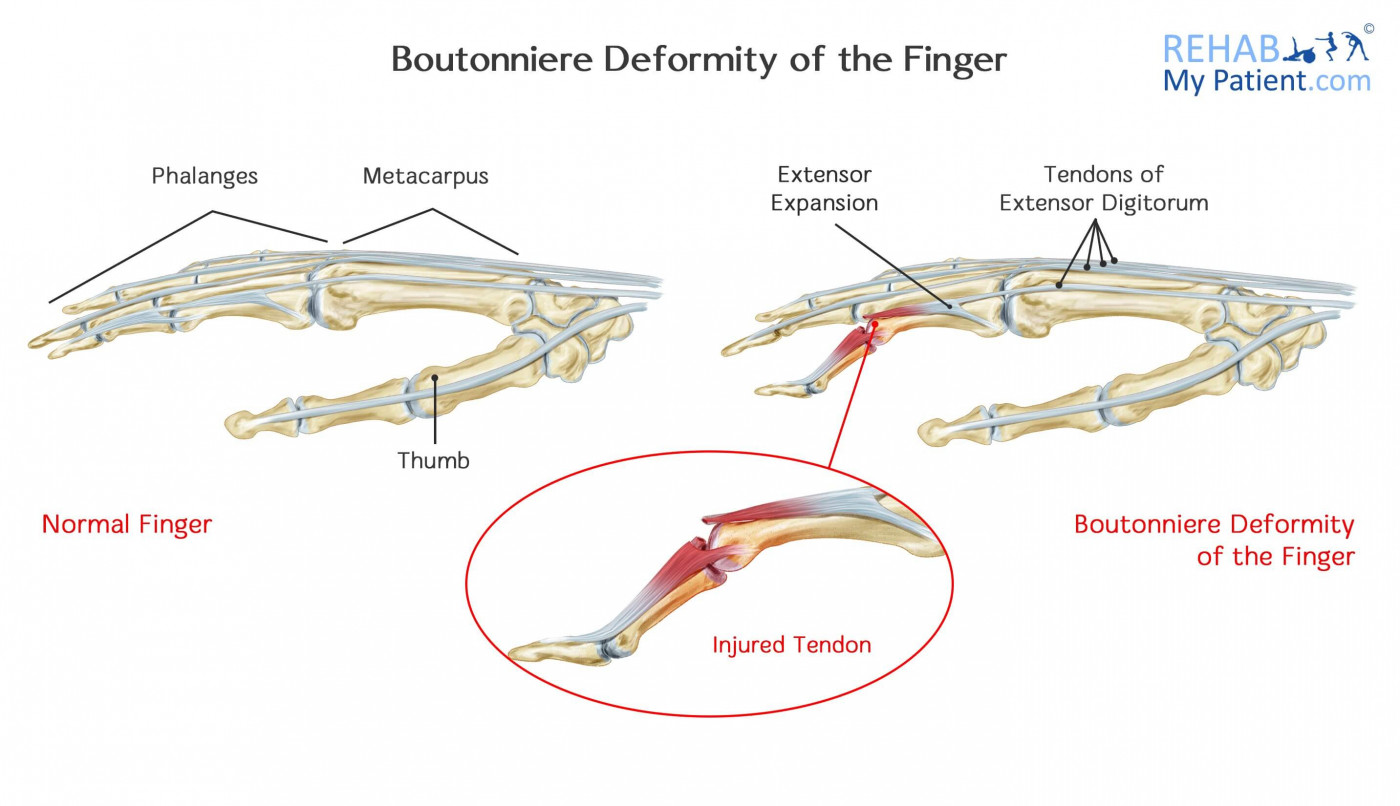Boutonniere Deformity of the Finger
Opublikowano dnia 14th Jul 2017 / Opublikowano w: Ręka/Palce/Kciuk

A boutonniere deformity results from an injury to the tendons of the fingers preventing the finger from being able to straighten fully. The result is the middle joint in the finger ends up bending down, while the tip of the finger bends backward. Those who have this shape have the classic sign of the boutonniere deformity. Unless the problem is treated quickly, the deformity could end up getting worse. As a result, impaired functioning and permanent deformity can occur.
The main cause is a strong blow to the top of the finger, and can occur in any impact sport like rugby, skiing, or hockey. Another cause can be cutting of the tendon from a tool or knife. Boutonniere means “button-hole” in French.
Boutonniere Deformity Anatomy
Several tendons in the finger work together for straightening and bending the finger. All of the tendons run alongside the top and side of the finger. Tendons at the top of the fingers will attach to the finger's middle bone. When that tendon becomes injured, the fingers aren’t able to straighten out fully.
 A patient who suffered a dislocated PIP joint, now relocated but still showing signs of deviation due to a torn ligament / volar plate injury.
A patient who suffered a dislocated PIP joint, now relocated but still showing signs of deviation due to a torn ligament / volar plate injury.
How to Treat a Boutonniere Deformity:
- Splint
A splint is applied to the middle joint of the finger to help straighten it out. The splint will help to keep the tendon's ends from separating during the healing process. It is imperative that the splint is worn for the specified length of time. In younger patients, the recommended time is six weeks. Elderly patients only need to wear the splint for three weeks. Following the immobilization period, you might be required to wear the splint overnight.
- Exercise
Most of the time, you may be provided with a series of recommended stretching exercises for improving upon the flexibility and strength in your fingers. By strengthening your fingers, you can help to prevent the condition from taking control of your tendons and bones.
- Protection
For those who participate in sports, you might need to wear a protective tape or splint for a few weeks following the removal of the splint.
- Surgery
Even though nonsurgical treatments for the deformity are often preferred, surgery is an alternative when certain conditions are present:
- The tendon is severed
- The deformity is the direct result of rheumatoid arthritis
- Large bone fragments are displaced from their normal position
- Conditions are not improving even with splinting
Surgery will help to reduce pain and help to improve function, but it might not be able to correct the problem fully and make the finger return to normal. If the deformity remains untreated for longer than three weeks, it can become quite difficult to treat and correct.
Tips:
- Boutonniere deformities are often attributed to your finger taking a forceful blow.
- Cuts on the top of the finger can sever the central slip from where it is attached to the bone.
- Depending on the severity of the condition, the bone could end up protruding through the opening of your tear.
- Arthritis has been known to cause a boutonniere deformity. Roughly, one-third of all individuals who have rheumatoid arthritis will end up with their fingers having this deformity.
- Signs of the deformity can develop immediately after an injury, but they can take up to 21 days to form.
Zapisać się
Zarejestruj się już teraz, aby skorzystać z bezpłatnego okresu próbnego!
Zacznij korzystać z Rehab My Patient już dziś i zrewolucjonizuj proces przepisywania ćwiczeń, aby zapewnić sobie skuteczną rehabilitację.
Rozpocznij 14-dniowy bezpłatny okres próbny